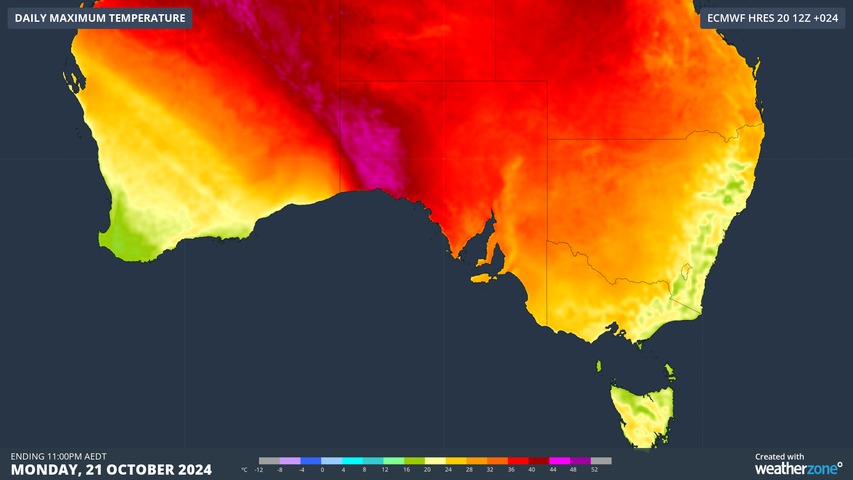Parts of South Australia, Victoria and Tasmania will experience a burst of warm weather at the start of this week, briefly increasing fire danger ratings in some areas.
The satellite images below show a cold front crossing southwestern Australia on Monday morning.

Image: Visible satellite images showing clouds over Australia on Monday morning.
This animation above reveals a large field of speckled clouds on the western side of the front, indicating a cold air mass coming from the southern Indian Ocean. Ahead of the cold front, a much warmer air mass is being driven towards southern Australia by a strengthening flow of pre-frontal northerly winds.
Warm air ahead of the approaching cold front will cause temperatures to climb around 8 to 12°C above average in parts of SA, Vic and Tas on Monday and Tuesday.

Image: Forecast near-surface air temperature anomaly at 5pm AEDT on Monday, October 21, according to the GFS model. Source: Tropical Tidbits
On Monday, temperatures are forecast to reach around 30°C in Adelaide and over 40°C in the west of SA. This heat is expected to cause Extreme fire danger in SA’s West Coast district and High fire danger in other western and central parts of the state on Monday.
A relatively weak southerly change will then bring cooler air to southern parts of SA on Tuesday as the hotter air is forced further east into Vic, Tas and southern NSW.
Melbourne is forecast to reach 29°C on Tuesday and Hobart should reach around 25°C, which are about 8 to 9°C above average for this time of year.
Parts of northwest Vic, western Tas and central and eastern SA could see High fire danger ratings on Tuesday amid the brief burst of warm weather.
While this two-day pulse of warm weather is not going to cause catastrophic fire danger, these spells of early-season heat can help dry out vegetation to create more fuel for fires in the summer months.
Working in often severe conditions in the high-risk fields of forestry and emergency, our consolidated weather services can ensure full situational awareness for you and your team.
DTN APAC serves the forestry and emergency sectors, delivering trusted weather data and severe weather alerting to maintain safety, protect your assets and underpin your planning.
Weatherzone’s trusted nowcasting and forecasting system, OpticastTM, is independently proven to outperform other industry models, allowing you to respond rapidly to changing conditions. Opticast can ingest data from your on-site weather observation equipment, ensuring your forecast is customised to your local microclimate. From nowcasting and 14 day forecasting to seasonal outlooks, you have powerful, hyper-local weather alerting and intelligence, giving you decisive confidence when it’s most needed.
With lightning a prominent cause of forest fires throughout Australia, Weatherzone’s Total Lightning Network offers real-time detection and unsurpassed accuracy of lightning strikes to <200m. Based on a vast sensor network, both intra-cloud and cloud-to-ground strikes are located, ensuring you are alerted when severe weather is building and threatening your teams, assets and infrastructure. When volatile conditions increase the ferocity of fire it’s imperative you have lead-time to enact safety plans, keeping your people out of harm’s way.
Your weather intelligence is accessible across all devices in your network via our Weatherguard App, and your customisable interface.
We are there for you when you need us the most – 24/7, 365 days a year. To find out more visit our contact page or email us at apac.sales@dtn.com.






